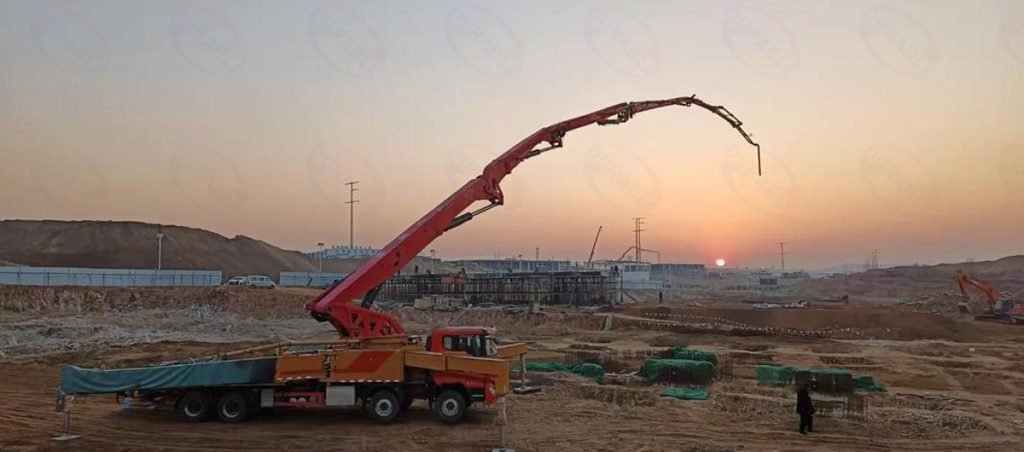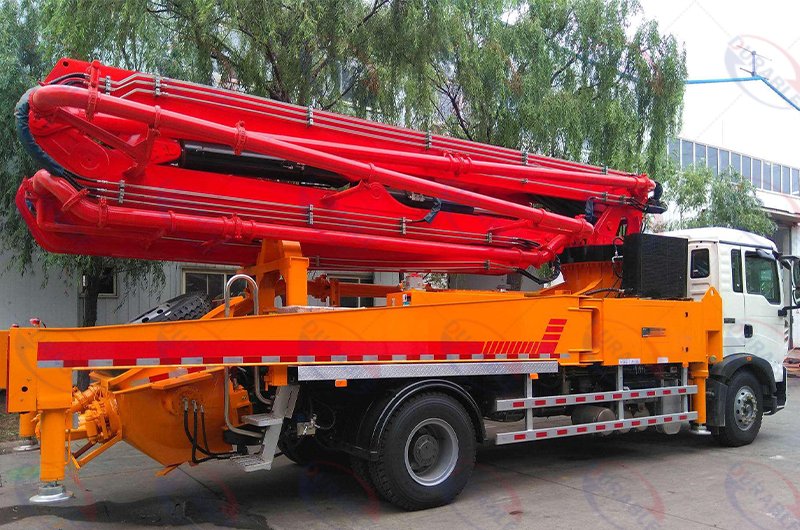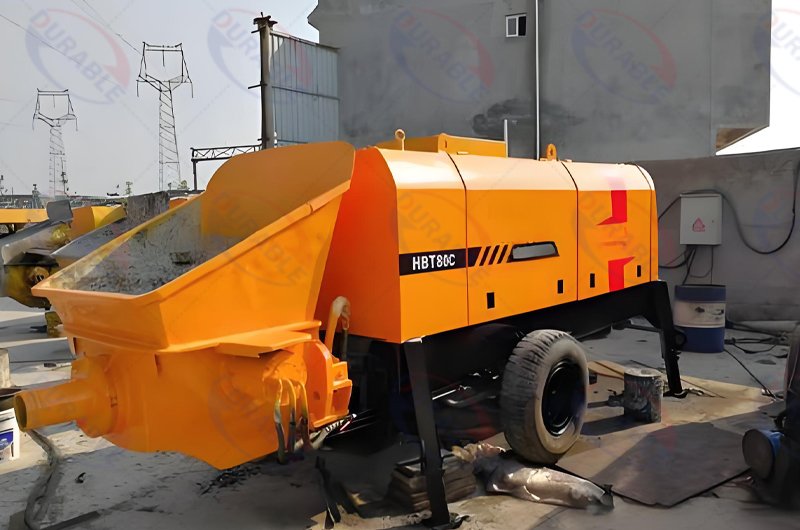Concrete Pump Buying Guide: A Complete Pumping Solution
On any modern construction site, moving concrete is a critical task. The old methods of using wheelbarrows or crane buckets are slow, labor-intensive, and often unsafe. As a leading manufacturer of construction machinery since 2001, we at Durable have seen how the right equipment can transform a project.
This concrete pump buying guide is designed to help you solve your most pressing construction challenges. The use of concrete pumps goes far beyond simple foundations. They are problem-solvers that boost efficiency, improve safety, and enable complex architectural designs.
This guide will provide a complete analysis of your pumping options. We will break down the differences between a concrete boom pump and a concrete trailer pump. We will help you understand which machine is the right investment for your specific projects. We want to empower you to make an informed decision that will lower your project costs and increase your profitability.
Table of Contents
- What Key Construction Problems Do Concrete Pumps Solve?
- How to Achieve Continuous Pumping Over Long Distances?
- Does Pumping Concrete Ensure Better Quality?
- How Do Pumps Optimize Labor and Improve Site Safety?
- Can Pumps Handle Special Projects Like Bridges and Tunnels?
- Boom Pump vs. Trailer Pump: How to Choose?
- How to Evaluate Your Return on Investment (ROI)?
- Common Questions About Concrete Pumps
- Summary: The Right Pump for a Profitable Project
- About Durable
- Start Your Pumping Solution Today
What Key Construction Problems Do Concrete Pumps Solve?
Beyond basic foundations, concrete pumps solve critical problems of height, distance, speed, and access. They are the key to unlocking modern construction productivity. Without pumps, many of the structures we see today would be impossible to build efficiently.
Think about a high-rise building. You cannot use wheelbarrows to move concrete 30 stories up. A pump makes this possible. Consider a large warehouse floor. You need to place thousands of cubic meters of concrete quickly and continuously. A pump can do this in a fraction of the time it would take with other methods. Or imagine a backyard swimming pool project. A large concrete truck cannot drive across a finished lawn. A pump can park on the street and easily snake its pipeline to the back of the house. In each of these cases, the use of concrete pumps overcomes a major logistical barrier. They turn what would be a logistical nightmare into a routine, manageable task. This ability to solve problems is what makes them one of the most valuable pieces of equipment on any job site.
How to Achieve Continuous Pumping Over Long Distances?
You can achieve continuous, high-efficiency pouring over long distances by using the right type of pump and pipeline setup. This is one of the most powerful capabilities of pumping concrete. The solution depends on whether your challenge is vertical or horizontal.

For vertical transport, such as in high-rise construction, a powerful concrete boom pump is often used for lower floors. As the building gets taller, a stationary pump is set up at the base. A vertical steel pipeline is run up the side of the building. The pump pushes concrete through this pipeline to the required floor. This method allows for the construction of modern skyscrapers. For long-distance transport horizontally, a concrete trailer pump (also called a line pump) is the ideal tool. You can connect multiple sections of steel pipe and flexible rubber hose to create a pipeline that can extend for hundreds of meters. This allows you to pump concrete across large sites, through existing buildings, or into tunnels. The key to continuous flow is a well-coordinated supply of ready-mix trucks feeding the pump’s hopper. This ensures the pump never runs dry, which is essential for creating a strong, solid structure without weak points.
Does Pumping Concrete Ensure Better Quality?
Yes, using a concrete pump significantly improves the final concrete quality by preventing segregation and ensuring a monolithic pour. Poor concrete quality can lead to structural failure and costly repairs. A concrete pump is a powerful tool for quality control.
When concrete is moved with wheelbarrows or dropped from a great height using a bucket, the heavier aggregates can separate from the cement paste. This is called segregation, and it creates weak spots in the final structure. The process of pumping concrete keeps the material under pressure in a closed pipeline. This prevents segregation from happening. The mix that comes out of the hose is the same high-quality mix that went into the hopper. Furthermore, a pump delivers a continuous, steady flow of concrete. This allows for a “monolithic” pour, where the entire structure is cast as a single solid piece. This avoids “cold joints,” which are weak planes that form when one layer of concrete starts to set before the next layer is poured on top. The continuous flow helps the concrete fill all corners of the formwork and consolidate tightly around steel reinforcement, resulting in a stronger, more durable, and higher-quality final product.
How Do Pumps Optimize Labor and Improve Site Safety?
A concrete pump drastically reduces the need for manual labor and creates a much safer work environment. This directly improves your construction efficiency and lowers your risk of accidents and injuries.
Imagine the labor needed to move 50 cubic meters of concrete with wheelbarrows. It would require a large crew of workers making hundreds of trips, creating a crowded and hazardous site. A single concrete pump with one operator and a small placement crew can do the same job in a fraction of the time. This frees up your valuable workers to focus on other important tasks like finishing and formwork. The safety benefits are just as significant. It eliminates the physical strain and risk of injury associated with manually moving heavy loads. It also reduces on-site traffic and congestion. There are no wheelbarrows creating trip hazards or large crane buckets swinging overhead. The worksite is cleaner, more organized, and fundamentally safer for everyone involved. This reduction in labor costs and improvement in safety contributes directly to a healthier bottom line.
Can Pumps Handle Special Projects Like Bridges and Tunnels?
Yes, concrete pumps are essential for challenging and special engineering projects like bridges, tunnels, and deep foundations. Their power and versatility make them the only practical solution for these complex applications.
In bridge construction, a concrete boom pump is perfect for reaching high piers and decks. Its long, articulated arm can navigate around obstacles and place concrete precisely where it is needed. For tunnels, a concrete trailer pump is used to pump concrete for the lining. It can be set up outside the tunnel entrance, with a long pipeline running inside to the formwork. This is also the method used for shotcreting, where concrete is sprayed at high velocity to stabilize tunnel walls. For deep foundations and piling, a pump is used to fill deep, narrow boreholes with concrete, often from a great distance. In all of these special projects, the ability to deliver a continuous, high-pressure flow of concrete to a hard-to-reach location is something that only a pump can provide. They are a core piece of equipment selection for any serious infrastructure contractor. To see a powerful option for these jobs, you can check out our Durable concrete boom pump.
Boom Pump vs. Trailer Pump: How to Choose?
The choice between a concrete boom pump and a trailer pump depends on your project’s need for reach versus flexibility. This is the most important part of your equipment selection process. They are both powerful tools, but they excel at different tasks.
The Concrete Boom Pump: The High-Reach Specialist
A concrete boom pump is a truck-mounted unit with a long, foldable robotic arm (the boom). Its main advantage is speed and reach. The operator can unfold the boom in minutes and precisely position the end hose high in the air or over obstacles. This makes it ideal for high-rise buildings, large foundations, and any project where you need to get concrete to a high or difficult-to-reach spot quickly. It is a self-contained unit that drives to the site, sets up, performs the pour, and drives away.
The Concrete Trailer Pump: The Versatile Workhorse
A concrete trailer pump (or line pump) is a smaller pump mounted on a trailer. It does not have a boom. Instead, you connect sections of steel pipe and rubber hose to create a pipeline to the pour site. Its main advantage is versatility. The pipeline can be run for very long distances, through buildings, up stairs, or into tight spaces where a boom truck cannot go. They are perfect for residential slabs, swimming pools, tunnel linings, and large horizontal pours. Some models, like our versatile concrete mixer pump, even include a mixer, giving you an all-in-one solution for remote sites.


| Feature | Concrete Boom Pump | Concrete Trailer Pump (Line Pump) |
|---|---|---|
| Best For | Height, speed, and reaching over obstacles. | Long distances, tight access, and versatility. |
| Typical Projects | High-rise buildings, large commercial foundations, bridges. | Residential slabs, tunnels, swimming pools, remote sites. |
| Setup Time | Fast. The boom unfolds quickly. | Slower. Requires connecting pipeline sections. |
| Reach | Limited by boom length (typically 20-70 meters). | Almost unlimited, can be hundreds of meters. |
| Mobility | Self-contained truck. High mobility between sites. | Must be towed to the site. |
| Initial Cost | Very high. | Moderate to low. |
How to Evaluate Your Return on Investment (ROI)?
To evaluate your ROI, you must look beyond the initial purchase price and consider the total cost of ownership and the revenue it generates. A concrete pump is a major investment, but it can provide a very fast return if used correctly.
First, calculate your potential savings. Compare the cost of a pump operator and a small crew to the cost of the large labor force you would need without a pump. The labor savings alone are often significant. Next, consider the increase in construction efficiency. A pump allows you to complete jobs much faster. This means you can take on more projects in a year, which directly increases your revenue. Faster completion also reduces your overhead project costs, such as equipment rental and site supervision fees. You also need to factor in operating costs. These include fuel, regular maintenance, wear parts (like pipes and pistons), and insurance. When you subtract these operating costs from the revenue generated by increased speed and labor savings, you can see the true profitability of the machine. For most contractors, the dramatic increase in productivity means a concrete pump pays for itself very quickly.
Common Questions About Concrete Pumps
Question 1: What kind of concrete mix can be pumped?
Most standard concrete mixes can be pumped. However, the mix must be designed for pumpability. This usually means it has a good balance of sand and aggregates and is not too dry or harsh. It is always best to discuss the mix with your ready-mix supplier.
Question 2: What is the most common maintenance issue with a concrete pump?
The most common maintenance involves wear parts. The pistons, pipes, and elbows that are in direct contact with the abrasive concrete will wear out over time and need to be replaced. Regular cleaning after every use is the single most important thing you can do to extend the life of your pump.
Question 3: How far can you actually pump concrete?
This depends on the power of the pump and the concrete mix. A powerful concrete trailer pump can push concrete over 1000 meters horizontally or over 300 meters vertically under the right conditions. A concrete boom pump‘s reach is defined by its boom length.
Summary: The Right Pump for a Profitable Project
Choosing the right concrete pump is a strategic business decision. This concrete pump buying guide has shown that the use of concrete pumps solves fundamental construction problems, making projects faster, safer, and more profitable. Whether you need the high-reach capability of a concrete boom pump for a skyscraper or the versatile flexibility of a concrete trailer pump for a complex ground-level project, the right machine is available. By analyzing your typical projects and understanding the difference between a boom pump and a line pump, you can select an asset that will increase your construction efficiency and deliver an excellent return on your investment.
About Durable
Since 2001, Durable has been a leading manufacturer and global supplier of high-quality construction machinery. We specialize in providing robust and reliable concrete pumping solutions to contractors in over 120 countries. Our factory-direct model means you get exceptional equipment at a competitive price, all backed by our dedicated team of engineers who are committed to your success.
Start Your Pumping Solution Today
Are you ready to boost your efficiency and tackle more challenging projects? Contact our equipment experts today. We will listen to your needs and help you select the perfect concrete pump for your business. Let us provide you with a detailed quote and show you how a Durable pump can be your most profitable investment.
 Durable Machinery
Durable Machinery